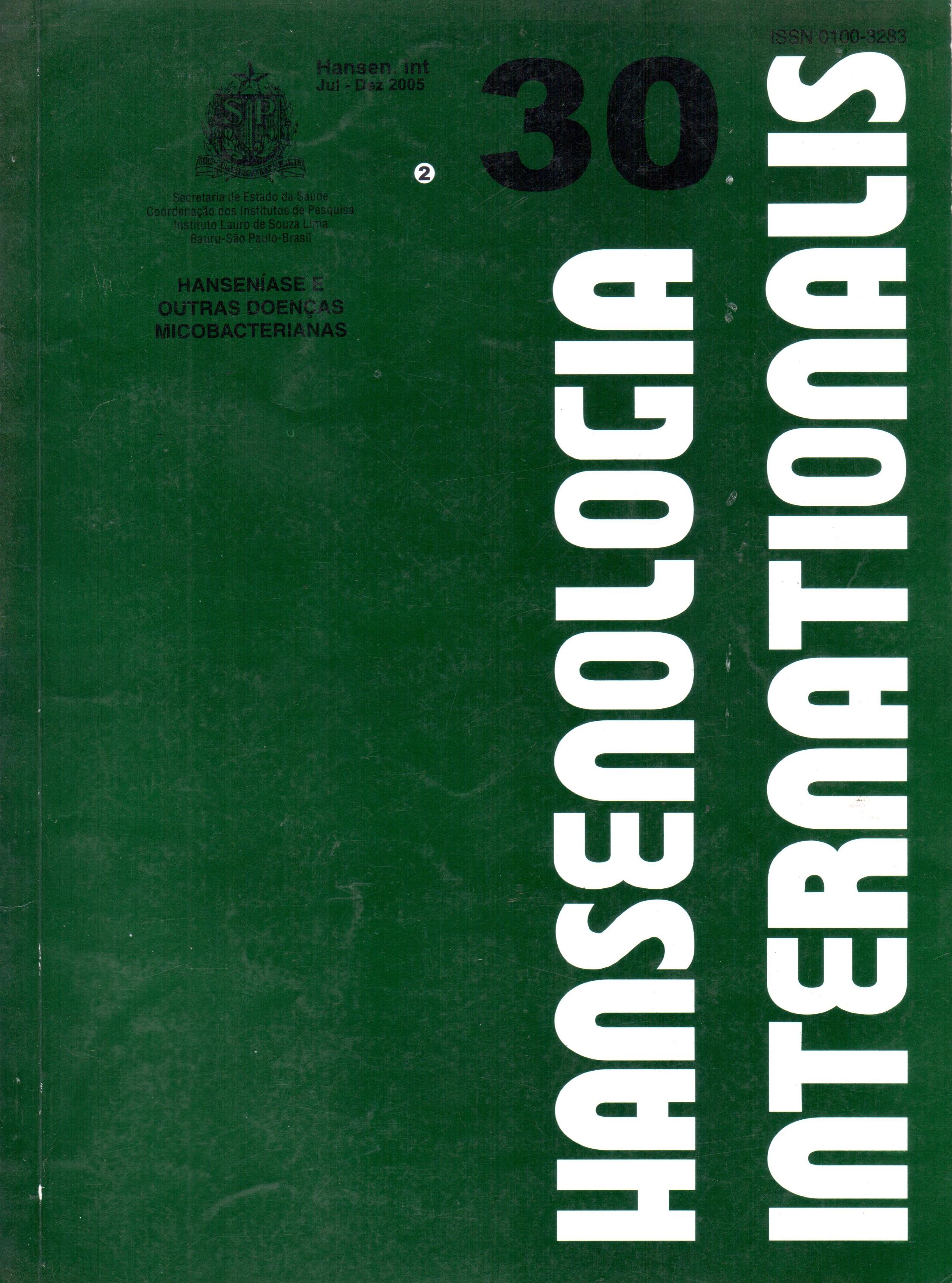Abstract
Leprosy is still a public health problem in Brazil. Sobral Municipality in the Central-North region of the State of Ceará(Northeast Brazil) is considered by the Ministry of Health one of the priority municipalities for leprosy control. To analyze the epidemiologic situation of leprosy in Sobral from 1997 to 2003, a descriptive longitudinal study was conducted. Data were obtained from the database of SINAN (Sistema de Informação de Agravos de Notificação - Information System of Notifiable Diseases). In the study period, 1,305 new cases of leprosy were notified; 661 (50.3%) were females and 644 (49.7%) were males. In 2003, the detection rate in the female sex was 23.8/10,000 women, an increase of 9.6% as compared to the male sex. The ighest
percentage of new cases was detected in 2003, with values above the expected when compared to the previous years. Borderline leprosy increased continuously, representing 67.5% of the notified cases in 2003. In 1997, most cases (70.4%) were paucibacillary. However, in the following years, multibacillary leprosy turned to be the predominant form, with proportions varying from 62.1% to 85.9% in the years 2002 and 2003, respectively. The detection rate increased from 10.0 cases/10.000 inhabitants in 1997 to 21.6 cases/10.000 inhabitants in 2003. The health services improved the detection of cases in the period; however, inconsistencies regarding age, sex, clinical form and operational classes were identified which indicate inadequate diagnosis of leprosy, mainly in 2003. The data emphasize the importance of critical analysis and monitoring of the epidemiologic situation in areas in which successful integration of leprosy control on the primary health care level has been reported.
References
2 Araujo MG. Hanseníase no Brasil. Rev Soc Bras Med Trop 2003; 36(3):373-382.
3 Meima A, Richardus JH, Habbema JDF. Trends in leprosy case detection worldwide since 1985. Lepr Rev 2004; 75:19-33.
4 Cunha SS, Rodrigues LC, Duppre NC. Current strategy for leprosy control in Brazil: time to pursue alternative preventive strategies? Rev Pan Salud Pública 2004; 16(5): 362-365.
5 Lockwood DNJ, Suneetha S. Leprosy: too complex a disease for a simple elimination paradigm. Bull World Health Organ 2005; 83(3): 230-235.
6 Ministério da Saúde (BR). Diretrizes do Programa da Hanseníase, 1986-1990. Brasília: Secretaria Nacional de Programas Especiais de Saúde. Divisão Nacional de Dermatologia Sanitária; 1986.
7 Ministério da Saúde (BR). Avaliação Independente do Programa Nacional de Controle e Eliminação da Hanseníase. Brasília: Fundação Nacional de Saúde - Centro Nacional de Epidemiologia. Coordenação Nacional de Dermatologia Sanitária; 1992.
8 Andrade VL, Sabroza PC, Araujo AJ. Fatores Associados ao Domicilio e à Família na Determinação da Hanseníase. Cad Saude Publica 1994; 10 Suppl 2:281-292.
9 Andrade VLG. A urbanização do tratamento da hanseníase. Hansen int 1995;20:51-59.
10 Andrade VLG. A evolução da hanseníase no Brasil e perspectivas para sua eliminação como problema de Saúde. [Tese]. Escola Nacional de Saúde Pública. Fundação Oswaldo Cruz; 1996.
11 Cunha SS, Rodrigues LC, Moreira S, Carvalho LC, Barreto ML, Dourado I. Upward trend in the rate of detection of new cases of leprosy in the State of Bahia, Brazil. Int J Leprosy 2001;69:308-317.
12 Ministério da Saúde (BR). Saúde Brasil 2004. Brasília: Ministério da Saúde. Secretaria de Vigilância em Saúde; 2004.
13 Ministério da Saúde (BR). Plano Nacional de Mobilização e Intensificação das Ações para Eliminação da Hanseníase e Controle da Tuberculose. Brasília, Ministério da Saúde; 2001.
14 Ministério da Saúde (BR). Guia de Vigilância Epidemiológica. 5a ed. Brasília: Fundação Nacional de Saúde; 2002.
15 Ministério da Saúde (BR). A definição dos municípios prioritários. Disponível em: <http://portal.saude.gov.br/portal/svs/visualizar_texto.cfm?idtxt=21606>. Acessado em maio de 2005.
16 Secretaria de Estado da Saúde (CE). Núcleo de Atenção à Saúde/Adulto e Idoso. Boletim Estadual de Avaliação Epidemiológica e Operacional da hanseníase no Ceará - Ano 2002. Fortaleza, SESACeará; 2003.
17 Ministério da Saúde (BR). Sistema Nacional de Vigilância em Saúde: relatório de situação: Ceará. Brasília: Ministério da Saúde. Secretaria de Vigilância em Saúde; 2005.
18 Ministério da Saúde (BR). Cartas de Eliminação da Hanseníase. Disponível em http://portal.saude.gov.br/portal/arquivos/pdf/carta_CE.pdf. Acessado em junho de 2005.
19 Instituto Brasileiro de Geografia e Estatística. Pesquisa Nacional por Amostragem de Domicílio 2005. Disponível em: www.ibge.gov.br. Acessado em junho de 2005.
20 Departamento de Informação e Informática do SUS-Ministério da Saúde. Cadernos de Informações de Saúde: Ceará 2005. Disponível em: http://tabnet.datasus.gov.br/tabdata/cadernos/ce.htm. Acessado em Maio de 2005.
21 Secretaria de Desenvolvimento Social e Saúde (CE). Plano Municipal de Saúde de Sobral. [mimeo]: 2001.
22 Flôr S. A história da hanseníase no município de Sobral. Especialização em Saúde da Família. [Monografia]. Escola de Saúde Pública do Ceará. Universidade Federal do Ceará; 2002.
23 Cunha AZS. Hanseníase: aspectos da evolução do diagnóstico, tratamento e controle. Cienc Saúde Coletiva 2002; 7(2):235-242.
24 Meima A, Smith WC, van Oortmarssen GJ, Richardus JH, Habbema JD. The future incidence of leprosy: a scenario analysis. Bull World Health Organ 2004;82(5):373-380.
25 World Health Organization. Guia para o controle da lepra. Rev Bras Leprol 1960;28:40-45.
26 Martelli CMT, Stefani MMA, Penna GO, Andrade ALSS. Brazilian endemisms and epidemics, challenges and prospects for scientific investigation: leprosy. Rev Bras de Epidemiologia 2002; 5(3):273-285.

This work is licensed under a Creative Commons Attribution 4.0 International License.
